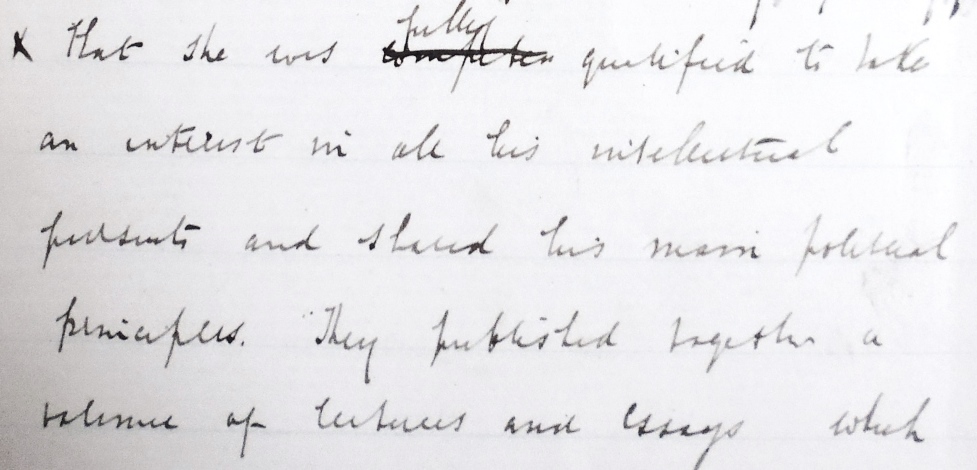It has recently been announced that Millicent Garrett Fawcett (1847-1929), who led the campaign for women’s suffrage, will be the first woman to be honoured with a statue in Parliament Square. This remarkable woman, also active in the struggle to improve women’s education, is well known as one of the principal founders of Newnham College Cambridge. So why does she feature in our series of blogs celebrating the THWomen40 anniversary? Well, she also had a connection to Trinity Hall!
In 1867 “Milly”, as she was known to her family, married Trinity Hall man and Member of Parliament, Henry Fawcett – or “Harry” to his friends. Here we take a look at their story through one of Trinity Hall’s manuscripts: a proof copy of the “Life of Henry Fawcett” by Leslie Stephen, which is written and marked up for publication in the author’s hand.

Extract from Leslie Stephen’s manuscript of “Life of Henry Fawcett”
Millicent Garrett as born in Aldeburgh in 1847 and came from a family of independent and high-achieving women. Her elder sister was Elizabeth Garrett Anderson, the first British female doctor. As a young woman, Milly became interested in women’s rights after attending a lecture on the subject by John Stuart Mill. At the age of just nineteen she became the Secretary of the London Society for Women’s Suffrage. Just one year later she married Henry Fawcett, a leading disciple of Mill! It was to be a happy marriage of like-minded radicals.
Leslie Stephen and Henry Fawcett met as mathematics undergraduates when Fawcett migrated from Peterhouse to Trinity Hall in 1855. They became great friends – first as undergraduates and then as Fellows of Trinity Hall. Henry Fawcett was already a Fellow when tragedy struck in 1858. On a visit home he lost his sight in a partridge shooting accident. With great courage and determination he decided that this misfortune should have no effect on his life. He continued his fellowship at Trinity Hall with the help of a young guide and amanuensis, Edward Brown, and went on to achieve great things, with a distinguished career as Professor of Political Economy at Cambridge, as a radical Member of Parliament and subsequently as Post Master General.

Here we have Stephen’s account of Harry’s marriage to Milly in 1867
Although Stephen’s biography of Harry makes only passing reference to Milly (out of Victorian delicacy about private life) when he does mention her it is always with admiration. He tells us that “in political and social questions their alliance implied the agreement of independent minds, not the relation of teacher and disciple” and that Harry’s “marriage was a main source of the happiness and success of his later career”.
On marriage Harry gave up his Trinity Hall Fellowship, as he was forced to do under the old rules, and was re-elected under the new rules. Milly had a central place in her husband’s life and in the Cambridge circle of academics and their wives. She ran the couple’s houses in Cambridge and London, but she was no stay-at-home housewife! She took over the role of amanuensis and was Harry’s guide, escorting him to the Houses of Parliament. She “was his adviser in most serious matters; and … when she was temporarily absent he would put off a decision of great moment in his career until he had been able to obtain her opinion”.

Stephen’s entry mentioning the Fawcett’s co-authorship of “Essays and lectures on social and political subjects”
She was also prolific author. Her first book “Political economy for beginners” (1870) was a great success, appearing in 10 editions. According to Stephen “she was fully qualified to take an interest in all his intellectual pursuits and shared his main political principles. They published together a volume of lectures and essays”. This volume was “Essays and Lectures on social and political subjects” (1872) which contained six chapters by Harry and eight chapters by Milly. Her biographer, David Rubinstein, states that she “was more talented than her husband”.
She was active in the movement for women’s suffrage and her husband “was always ready to support her efforts in a cause in which she naturally took the leading part”. After the death of her husband on 6 November 1884 she temporarily withdrew from public life. She later became president of the National Union of Women’s Suffrage Societies (1897-1919) and was a tireless campaigner on a number of issues. In July 1901 she was appointed to lead the British Government’s commission to South Africa to investigate conditions in the concentration camps that had been created there in the wake of the Second Boer War.
Millicent Garret Fawcett is considered instrumental in gaining the vote for six million British women over 30 years old in 1918. Theresa May, said in a statement that Dame Millicent “continues to inspire the battle against the injustices of today”. All 11 statues in Parliament Square are currently of men. It is wonderful that this remarkable woman with such a strong connection to Trinity Hall will be the first woman to join them!
References
“Life of Henry Fawcett” by Leslie Stephen (London: Smith, Elder, & Co., 1886)
“A different world for women: the life of Millicent Garrett Fawcett” by David Rubinstein (London: Harvester Wheatsheaf, 1991)
“Essays and lectures on social and political subjects” by Henry Fawcett and Millicent Garrett Fawcett (London: Macmillan, 1872)
“Political economy for beginners” by Millicent Garrett Fawcett (London: Macmillan, 1870)
BBC News article “Millicent Fawcett to be first woman statue in Parliament Square” http://www.bbc.co.uk/news/uk-39471407
Wikipedia on Millicent Garrett Fawcett https://en.wikipedia.org/wiki/Millicent_Fawcett